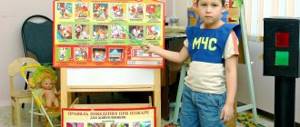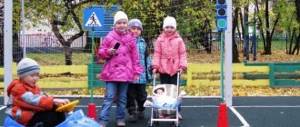Traffic rules quiz for preschoolers. Preparatory group
Quiz for pre-school children on traffic rules.
Purpose : This quiz can be used by kindergarten teachers to clarify and consolidate children’s knowledge of traffic rules, which in turn helps prevent road accidents involving children. Goal: To develop knowledge, skills and practical skills for safe behavior on the road and street. Summarize children's knowledge about traffic rules. Objectives: 1) Clarify children’s knowledge about the operation of traffic lights in a playful way. 2) Expand children’s understanding of the purpose of road signs. 3) Develop the ability to listen to peers, put forward and prove your assumptions. 4) Contribute to the development of self-regulation of one’s own actions.
Preliminary work:
Reading fiction on the topic: N. Nosov “Car”, B. Zhitkov “Traffic Light”, V. Klimenko “Bunny Cyclist”, “An Incident with Toys”, “Who is Most Important on the Street”;
Memorizing poems on the topic; Conversations on the topic; D/i “Road Signs”, “Laws of Streets and Roads”, “Domino Signs”; Guessing riddles; Excursions to controlled and unregulated intersections; Design of corners in the “Observe traffic rules” group. Materials : scoreboard for the jury, 2 tables, chairs according to the number of children, playing field with colored sectors, 2 envelopes with 10-12 signs, 2 envelopes with cut signs, tape recorder, recording of the music video “Wizards of the Bibika yard”, thematic music.
Quiz progress:
Music is playing.
Children enter the hall and stand in a semicircle. Inspect the decoration of the hall. Educator: Guys, every day you come to kindergarten with adults: mothers, fathers, grandparents, but soon you will go to school, and you will have to walk the streets and cross the road on your own. We have a big, beautiful city with wide streets. The roadway in our city is very busy, with cars, trucks, and buses moving along it. And no one bothers anyone, because there are clear and strict rules for drivers and pedestrians. What are these rules called? Children: Traffic rules. Educator: They don’t just walk around the city or on the street: When you don’t know the rules, it’s easy to get into trouble. Be careful at all times and remember in advance: The driver and the pedestrian have their own rules! (“Rules” by Y. Pishumov, excerpt) Educator: Today we met with you for a reason. We are waiting for a fascinating quiz on the rules of the road. To do this, I suggest you divide into 2 teams, come up with names for them and choose team captains. Children are divided into teams, they choose a name and a captain. Educator: And so, today the team “…” (children say the name in unison) and the team “…” meet. I ask the teams to take their seats. The children go to their places. Educator: And the performance of our teams will be assessed by our jury... Attention, we are starting our game. Look, in front of you is a large circle, divided into parts of red, yellow and green, and in the middle there is an arrow with which you will select questions for your team. If the arrow points to red, then the question will be easy, to yellow - more difficult, and to green - this means completing the proposed task. Accordingly, the number of points will also differ, depending on the complexity of the question and the quality of the answer. We invite a team representative... to select a question. Questions for the red sector: 1) Why do you need to know the rules of the road? (To avoid getting into a difficult situation on the road) 2) Who are pedestrians? (People who do not travel by transport) 3) Where should pedestrians walk? (On the sidewalk, along the pedestrian crossing) 4) What signals does the traffic light give and what do they mean? (Red - traffic is prohibited, yellow - attention, green - traffic is allowed) Questions for the yellow sector: 1) What parts does the street consist of? (Roadway, sidewalk, buildings) 2) Which side of the sidewalk should pedestrians stay on? Why? (On the right side so that pedestrians do not collide) 3) What is the purpose of the traffic light? (To regulate the movement of drivers and pedestrians) 4) How should children cross the road? (With an adult by the hand, and if a small child, then in the arms of an adult along the pedestrian crossing) Questions for the green sector: 1) Where and how should pedestrians walk if there is no sidewalk? (On the roadway, towards moving traffic) 2) What does the word traffic light mean? (From Russian light and Greek foros - “carrying”) 3) There are 2 types of traffic lights at the intersection: three-section and pedestrian. You need to cross the street. Whose signals will you follow? (Pedestrian traffic light) 4) What will you do if you are caught in the middle of the roadway by a yellow traffic light?
(At the traffic island we will wait for the green signal for pedestrians) The results are summed up. The jury gives scores. Educator: And now I suggest you relax and move to cheerful music. The music video “Wizards of the Courtyard - Bibika” is shown (children move in accordance with the text) Educator: Sit down in your seats. The teacher reads out the poem: The city in which you and I live can rightfully be compared to a primer. With the alphabet of streets, avenues, roads, the city gives us a lesson all the time. Here it is, the alphabet, - Above your head: Signs are hung along the pavement. Always remember the alphabet of the city, so that trouble does not happen to you. (“The ABC of the City” by Y. Pishumov) Look at your tables, there are envelopes with signs on them. You need to divide the signs into groups and explain your decision to the team captains. Get started. (All signs (10-12 pieces) must be divided into permitting, prohibiting and warning) Summing up the results of this competition by the jury. Educator: And the last captain competition for today. They need to assemble a sign from parts (see Appendices) and tell everything they know about it. Summing up the results of the competition - captains. The jury announces the total score of the teams. Teams are awarded. Literature used:
1) Romanova E. A., Malyushkina A. B. Classes on traffic rules. Publisher: Sfera, 2013 Editor: Tabolina E. E. 2) Saulina T.F.
Three traffic lights: Familiarization of preschoolers with the rules of the road: For working with children 3-7 years old. - M.: - Mosaic-Sintez, 2009. - 112 p. Applications:
Signs
We recommend watching:
Summary of an integrated lesson on traffic rules in the preparatory group Summary of a lesson for children 5-7 years old “Travel according to the rules of the road” Sports festival on traffic rules for children 5-7 years old. Scenario: Entertainment according to traffic rules in the preparatory group. Scenario
Similar articles:
Tasks on traffic rules for preschoolers in pictures
Learning traffic rules in kindergarten
Lesson on traffic rules in kindergarten for children of the preparatory group. Traffic certificate
Game quiz on traffic rules in the preparatory group of kindergarten
Summary of a lesson on traffic rules for children of the preparatory group at the kindergarten site





